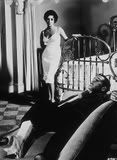Cat on a Hot Tin Roof 
What should have been an easy job for make-up artist William Tuttle, letting the natural beauty and sexuality of stars Elizabeth Taylor and Paul Newman shine through in the film version of Tennessee Williams' Cat on a Hot Tin Roof (1958), became a major challenge immediately following the tragic death of Mike Todd, Taylor's husband at the time. Tuttle suddenly had to erase all signs of grief and desolation in his lead actress. That the on-screen Taylor bore no resemblance to the tragic widow off-screen was a testimony to both the star's tenacity and the artistry of the MGM production team.
Cat on a Hot Tin Roof was a film book-ended by tragedy. MGM had bought screen rights to Williams' Pulitzer Prize-winning play shortly after it took Broadway by storm. Originally they planned to star James Dean as Brick, the former college football star sunk in alcoholic despair over the loss of his best friend, Skipper; fear that his feelings for Skipper were more than friendly; and a betrayal by his beautiful wife, Maggie. But it took so long to come up with a screenplay that would be true to Williams' sexually charged story while still getting past the industry's Production Code censors, that Dean never made it to the screen in the role. He was killed in a car crash after starring in only three films. Instead, the role went to Paul Newman, a rising young star who would inherit several roles planned for Dean.
The delays also cost MGM their original leading lady when Grace Kelly left acting to become Princess of Monaco. The timing was perfect for Taylor, however. She had just scored meaty roles in Giant (1956) and Raintree County (1957) and, at the urging of third husband Mike Todd, was eager to establish herself as a solid dramatic actress. Todd negotiated a new contract for Taylor with MGM that gave her the role of Maggie and her freedom from MGM in return for just one more picture at the studio where she had started her career more than a decade earlier.
Early in the shooting schedule, Todd had to go to New York to accept an award. He wanted Taylor and director Richard Brooks to accompany him, but she had a virus, and Brooks was too busy trying to bring the production in on time, so they stayed behind. Despite her illness, Taylor barely slept, waiting for Todd to call, as he had promised, each time his private plane touched down. By the time the news reached her that the plane had crashed, killing all on board, she had been up all night, desperate because he hadn't called her at all.
Todd's funeral in Chicago was a nightmare, as fans besieged the heavily sedated Taylor throughout the trip to and from the cemetery. Afterwards, she holed up in her rented home while Brooks shot around her. Three weeks later, she visited the set and asked if she could start work that day, claiming that "Mike would have wanted it this way." Brooks arranged the schedule to catch her at her best, shooting her most difficult scenes in the early afternoon. Seeing how much weight she had lost, he ordered real food to replace the prop food for a dinner scene, then required extra takes, forcing Taylor to start eating again.
Despite her personal pain, Taylor dug into the role with a vengeance, turning in one of her best performances. By the time the picture was ready to come out, however, she had another problem. During post-production, she had started an affair with Todd's closest friend, the very married Eddie Fisher. When his wife, MGM actress Debbie Reynolds, filed for divorce, the scandal almost destroyed Fisher's career. But it helped make Cat on a Hot Tin Roof the studio's biggest box-office hit of the year, with almost $10 million in box-office returns. When Taylor won an Oscar® nomination for her performance, Reynolds canceled plans to present at the ceremonies. Though Taylor lost to Susan Hayward for I Want to Live!, she still dominated coverage of the awards. And just to add a comic footnote to the proceedings, Fisher sang one of the nominated songs, the aptly titled "To Love and Be Loved."
Producer: Lawrence Weingarten
Director: Richard Brooks
Screenplay: Richard Brooks, James Poe
Based on the play by Tennessee Williams
Cinematography: William Daniels
Art Direction: William A. Horning, Urie McCleary
Cast: Elizabeth Taylor (Maggie Pollitt), Paul Newman (Brick Pollitt), Burl Ives (Big Daddy Pollitt), Jack Carson (Gooper Pollitt), Judith Anderson (Big Mama Pollitt), Madeleine Sherwood (Mae Pollitt).
C-109m. Letterboxed. Closed captioning. Descriptive video.
by Frank Miller